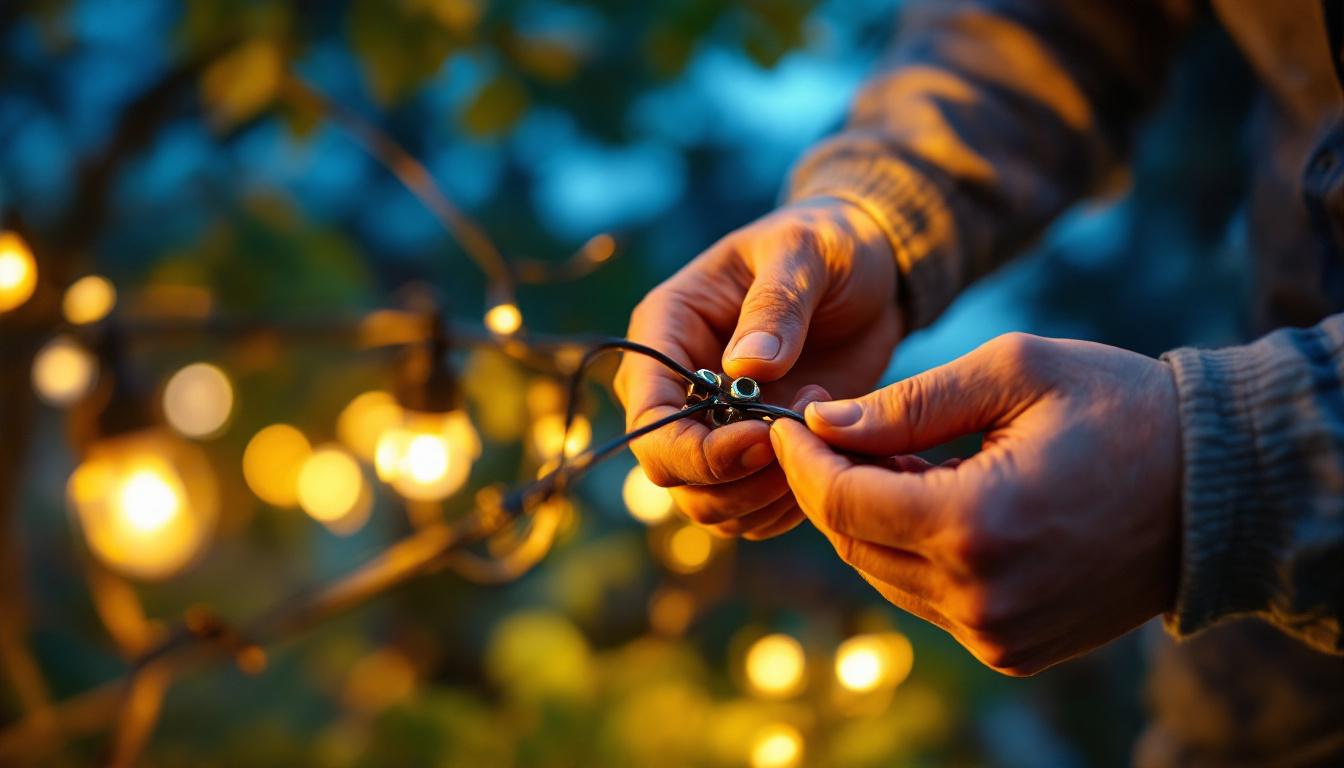
When it comes to landscape lighting projects, the importance of using the right materials cannot be overstated. Among these materials, wire nuts play a crucial role in ensuring that connections are secure and reliable. However, improper use or selection of wire nuts can lead to costly mistakes that may affect the overall success of a lighting installation. This article delves into the essential aspects of landscape lighting wire nuts, providing insights on how to avoid common pitfalls.
Wire nuts, also known as twist-on wire connectors, are essential components in electrical installations. They are designed to connect two or more wires securely, providing a reliable electrical connection. In landscape lighting, where outdoor conditions can be unpredictable, using the right wire nuts is vital to ensure longevity and safety. The proper use of wire nuts not only enhances the durability of the electrical system but also minimizes the risk of electrical shorts or failures that could lead to costly repairs or safety hazards.
Wire nuts come in various sizes and types, each suited for different applications. The most common types include:
Choosing the right type of wire nut is crucial for the specific conditions of a landscape lighting project. For example, using standard wire nuts in a damp environment can lead to corrosion and failure of the connection. Additionally, some wire nuts are color-coded, which helps in quickly identifying the appropriate size and type needed for various wire gauges. This color-coding system can save time and reduce errors during installation, making it an invaluable feature for both professionals and DIY enthusiasts.
Another critical factor to consider is the size of the wire nut. Using a wire nut that is too small can lead to poor connections, while one that is too large may not hold the wires securely. It is essential to match the wire nut size to the gauge of the wire being used. Most manufacturers provide guidelines on which sizes are compatible with specific wire gauges, making it easier to select the appropriate connector. Furthermore, when connecting multiple wires, it’s important to ensure that the total number of wires does not exceed the wire nut’s capacity, as this can compromise the integrity of the connection.
In addition to size and type, the installation technique also plays a significant role in the effectiveness of wire nuts. Properly stripping the wire ends and ensuring they are twisted together before applying the wire nut can greatly enhance the connection’s reliability. A well-made connection will not only prevent electrical issues but also reduce the risk of overheating, which can occur if the wires are not securely fastened. For those unfamiliar with electrical work, it may be beneficial to consult with a professional or refer to instructional resources to ensure that the installation meets safety standards and performs optimally.
Even experienced lighting contractors can fall prey to mistakes when working with wire nuts. Understanding these common errors can help prevent costly setbacks in landscape lighting projects.
One of the most significant mistakes is neglecting the environmental factors that can affect wire connections. Outdoor installations are exposed to various elements, including moisture, temperature fluctuations, and UV radiation. Using wire nuts that are not rated for outdoor use can result in premature failure. Always opt for weatherproof wire nuts when working in environments where exposure to the elements is a concern. Additionally, consider the geographical location of the installation site. Areas prone to heavy rainfall or extreme temperatures may require extra precautions, such as using silicone sealants or heat shrink tubing to further protect connections from moisture and temperature-induced damage.
Another common mistake is improper installation techniques. Simply twisting wires together and applying a wire nut is not enough. It is essential to strip the wires to the correct length and ensure they are twisted together tightly before securing them with a wire nut. A loose connection can lead to arcing, which poses a fire hazard and can damage the lighting system. Furthermore, it’s crucial to ensure that the wire nut is the appropriate size for the number of wires being connected. Overcrowding a wire nut can lead to poor connections, while using one that’s too large may not provide a secure fit. Always double-check the manufacturer’s specifications to ensure a safe and effective installation.
To ensure the success of landscape lighting projects, following best practices when using wire nuts is essential. These practices can help maintain the integrity of electrical connections and enhance the overall performance of the lighting system.
When preparing wires for connection, it is crucial to strip them to the appropriate length. Typically, a length of about 3/4 inch is sufficient for most wire nuts. Stripping too little can lead to weak connections, while stripping too much can expose excess wire, increasing the risk of short circuits. Additionally, using a wire stripper that is designed for the specific gauge of wire you are working with can make the process easier and more precise. A clean cut ensures that the copper strands are not damaged, which can also affect conductivity and the overall performance of your lighting system.
After stripping the wires, they should be twisted together firmly. This step is critical in ensuring a solid connection. A good rule of thumb is to twist the wires together at least three times. This not only helps in creating a secure connection but also minimizes the risk of the wires coming apart when the wire nut is applied. It’s also important to consider the direction of the twist; twisting in the same direction as the wire nut will help the nut grip the wires more effectively. If you are working with multiple wires, ensure that they are all aligned properly before twisting, as misaligned wires can lead to uneven pressure and potential connection failures.
Once the wire nuts are installed, it is essential to test the connections before finalizing the installation. This can be done using a multimeter to check for continuity. Ensuring that all connections are secure and functioning correctly can save time and money in the long run by preventing future issues. Additionally, it is wise to visually inspect each connection for any signs of fraying or damage, as well as ensuring that the wire nuts are securely fastened. If you notice any irregularities, it may be necessary to redo the connection to guarantee safety and reliability. Furthermore, consider labeling your connections, especially in complex setups, as this can aid in future troubleshooting or upgrades to your landscape lighting system.
The quality of wire nuts can significantly impact the performance of a lighting system. Investing in high-quality connectors can prevent many of the issues associated with cheaper alternatives.
When selecting wire nuts, look for indicators of quality, such as:
While it may be tempting to choose cheaper wire nuts to cut costs, this decision can lead to more significant expenses down the line. Low-quality connectors may fail prematurely, resulting in costly repairs or replacements. Investing in quality wire nuts is a wise decision that pays off in the long run.
Regular maintenance and inspection of landscape lighting systems are crucial for ensuring their longevity and performance. Wire connections should be included in these maintenance routines.
Establishing a schedule for inspecting wire connections can help identify potential issues before they escalate. During inspections, check for signs of corrosion, loose connections, or damaged wire nuts. Addressing these issues promptly can prevent more extensive damage and costly repairs.
In some cases, dirt and debris can accumulate around wire connections, leading to poor performance. Gently cleaning the area around wire nuts can help maintain optimal performance. However, care should be taken to avoid damaging the connections during the cleaning process.
Landscape lighting projects require meticulous attention to detail, especially when it comes to electrical connections. Wire nuts play a vital role in ensuring that these connections are secure and reliable. By understanding the different types of wire nuts, avoiding common mistakes, and following best practices, lighting contractors can enhance the success of their projects.
Investing in quality materials, conducting regular maintenance, and adhering to safety standards will not only improve the performance of landscape lighting systems but also protect the integrity of the installation. By prioritizing these elements, contractors can avoid costly mistakes and deliver exceptional results for their clients.
Ready to elevate your landscape lighting projects with the highest quality wire nuts and lighting accessories? Look no further than LumenWholesale. Our commitment to providing contractors with spec-grade lighting products at unbeatable wholesale prices means you can trust us to supply all your project needs. With free shipping on bulk orders, you can stock up on superior lighting products at the best value, ensuring your installations shine with reliability and excellence. Don’t let hidden fees dim your project’s potential. Explore our selection and start saving with LumenWholesale today.

Discover the top benefits of sconce lighting fixtures for lighting contractors.

Discover the essential guide to optimizing warehouse lighting with our comprehensive layout calculator.

Discover the pros and cons of semi flush mount lighting compared to other popular options.

Discover how inexpensive LED lights can transform your lighting projects without breaking the bank.